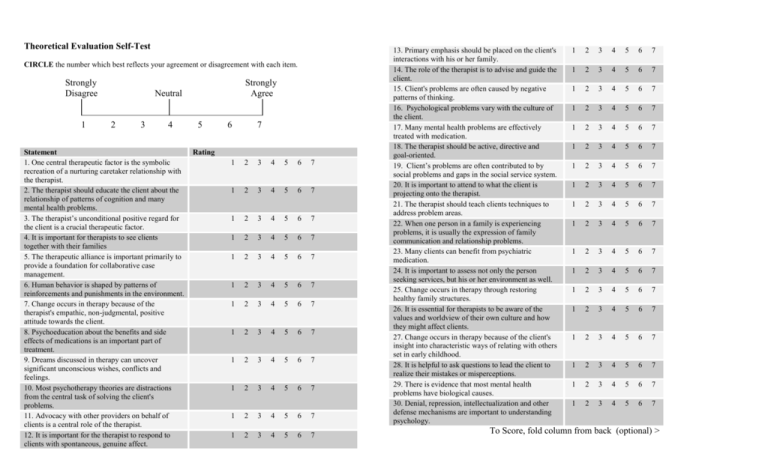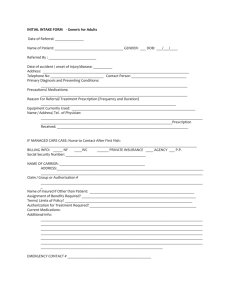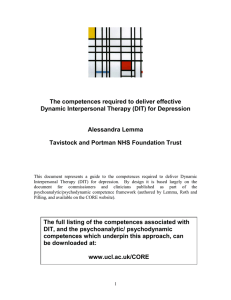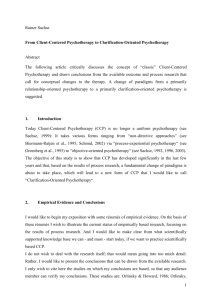Theoretical Orientation Self-Test
advertisement

Theoretical Evaluation Self-Test CIRCLE the number which best reflects your agreement or disagreement with each item. Strongly Disagree 1 Strongly Agree Neutral 2 3 4 Statement 1. One central therapeutic factor is the symbolic recreation of a nurturing caretaker relationship with the therapist. 2. The therapist should educate the client about the relationship of patterns of cognition and many mental health problems. 3. The therapist’s unconditional positive regard for the client is a crucial therapeutic factor. 4. It is important for therapists to see clients together with their families 5. The therapeutic alliance is important primarily to provide a foundation for collaborative case management. 6. Human behavior is shaped by patterns of reinforcements and punishments in the environment. 7. Change occurs in therapy because of the therapist's empathic, non-judgmental, positive attitude towards the client. 8. Psychoeducation about the benefits and side effects of medications is an important part of treatment. 9. Dreams discussed in therapy can uncover significant unconscious wishes, conflicts and feelings. 10. Most psychotherapy theories are distractions from the central task of solving the client's problems. 11. Advocacy with other providers on behalf of clients is a central role of the therapist. 12. It is important for the therapist to respond to clients with spontaneous, genuine affect. 5 6 7 Rating 1 2 3 4 5 6 7 1 2 3 4 5 6 7 1 2 3 4 5 6 7 1 2 3 4 5 6 7 1 2 3 4 5 6 7 1 2 3 4 5 6 7 1 2 3 4 5 6 7 1 2 3 4 5 6 7 1 2 3 4 5 6 7 1 2 3 4 5 6 7 1 2 3 4 5 6 7 1 2 3 4 5 6 7 13. Primary emphasis should be placed on the client's interactions with his or her family. 14. The role of the therapist is to advise and guide the client. 15. Client's problems are often caused by negative patterns of thinking. 16. Psychological problems vary with the culture of the client. 17. Many mental health problems are effectively treated with medication. 18. The therapist should be active, directive and goal-oriented. 19. Client’s problems are often contributed to by social problems and gaps in the social service system. 20. It is important to attend to what the client is projecting onto the therapist. 21. The therapist should teach clients techniques to address problem areas. 22. When one person in a family is experiencing problems, it is usually the expression of family communication and relationship problems. 23. Many clients can benefit from psychiatric medication. 24. It is important to assess not only the person seeking services, but his or her environment as well. 25. Change occurs in therapy through restoring healthy family structures. 26. It is essential for therapists to be aware of the values and worldview of their own culture and how they might affect clients. 27. Change occurs in therapy because of the client's insight into characteristic ways of relating with others set in early childhood. 28. It is helpful to ask questions to lead the client to realize their mistakes or misperceptions. 29. There is evidence that most mental health problems have biological causes. 30. Denial, repression, intellectualization and other defense mechanisms are important to understanding psychology. 1 2 3 4 5 6 7 1 2 3 4 5 6 7 1 2 3 4 5 6 7 1 2 3 4 5 6 7 1 2 3 4 5 6 7 1 2 3 4 5 6 7 1 2 3 4 5 6 7 1 2 3 4 5 6 7 1 2 3 4 5 6 7 1 2 3 4 5 6 7 1 2 3 4 5 6 7 1 2 3 4 5 6 7 1 2 3 4 5 6 7 1 2 3 4 5 6 7 1 2 3 4 5 6 7 1 2 3 4 5 6 7 1 2 3 4 5 6 7 1 2 3 4 5 6 7 To Score, fold column from back (optional) > Fold this column, transfer your response, and sum. COLUMN1 COLUMN2 To compare scales, Divide each sum by # of items. Compare your summed scale score to the responses of 130 subjects. PSYCHODYNAMIC 1_________ 9_________ 20________ 27________ 30________ Sum ______ /5 = _______ 26.2 (5.2) BIOLOGICAL 8_________ 17________ 23________ 29________ Sum_______ /4 = _______ 14.6 (4.0) FAMILY 4_________ 13________ 22________ 25________ Sum ______ Mean (sd) /4 = _______ 18.2 (4.0) ECOSYSTEMS 16________ 19________ 24________ 26________ Sum ______ /4 = _______ 24.2 (2.6) COGNITIVE 2_________ 6_________ 15________ 21________ 28________ Sum_______ /5 = _______ 25 (4.5) PRAGMATIC 5__________ 10_________ 11_________ 14_________ 18_________ Sum_______ HUMANISTIC 3_________ 7_________ 12________ Sum______ INTERPRETING YOUR SCORE: The subscales you used to add up your scores (psychodynamic, biological, etc) are derived from a factor analysis of the responses of 130 subjects. See below for sample information (footnote 1). Column 1 allows you to standardize your subscale scores by dividing the subscale sum by the number of items in that scale. With these 1 item equivalents you can examine which orientations you tend to score more highly on, and which are lower. If you chose to not make the calculation, notice which subscales have 5,4, and 3 items and you can make comparisons within these groups. Some participants have found it helpful to refer back to their responses to individual items to see if there are parts of a theory they tend to agree with more or less. Column 2 provides the means and standard deviations of the sample of 130 community clinicians. Since these are from one selectively drawn sample, they provide a reference point but are not Anorms@. (These are means of the summed scale scores, not standardized to the 1 item level). /3 = _______ 20.1 (5.7) 10.4 (2.4) © 2000. Daniel Coleman, Ph.D. Limited permission granted to reproduce for educational use. To aid you in interpretation the mean +/- 1 standard deviation would include 68% of the sample, and +/- 2 standard deviations would include 95% of the sample. One caution is that the reliability of the scales is adequate to discriminate group differences, but not individual differences. These scores should be used to stimulate reflection, but not as precise measurements of individual theoretical orientation. contact: 1 /5 = _______ THEORETICAL EVALUATION SELF TEST (TEST) Sample Information: (n=130) Fifty-six (43%) of the subjects were MSW students, and 74 (57%) were practicing clinicians. Ninety-three (72%) were social work associated (students and practitioners) and 37 (28%) were from the other mental health professions. The average age of subjects was 35 (sd=13.7). The average practice experience of practitioners was 13.8 years (sd=11.2). Daniel Coleman, M.S.W., Ph.D. Assistant Professor 264 Bay State Road Boston MA 02215 617.353.7885 email coleman1@bu.edu










